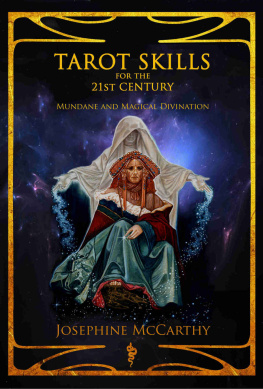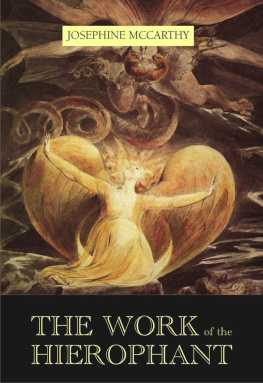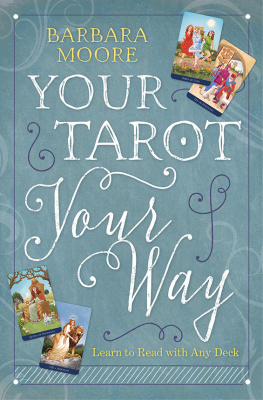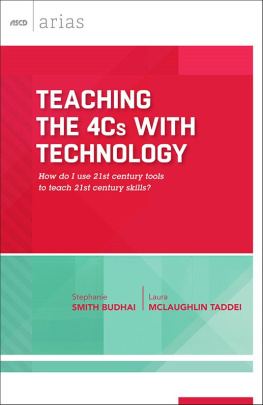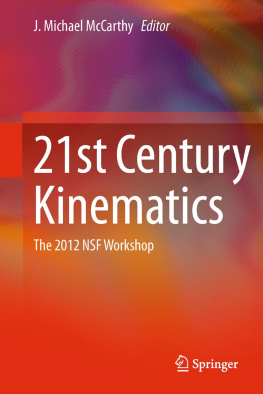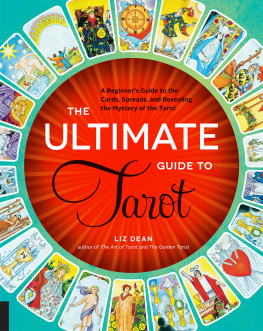Josephine McCarthy - Tarot Skills for the 21st Century
Here you can read online Josephine McCarthy - Tarot Skills for the 21st Century full text of the book (entire story) in english for free. Download pdf and epub, get meaning, cover and reviews about this ebook. year: 2020, publisher: Quareia Publishing, genre: Religion. Description of the work, (preface) as well as reviews are available. Best literature library LitArk.com created for fans of good reading and offers a wide selection of genres:
Romance novel
Science fiction
Adventure
Detective
Science
History
Home and family
Prose
Art
Politics
Computer
Non-fiction
Religion
Business
Children
Humor
Choose a favorite category and find really read worthwhile books. Enjoy immersion in the world of imagination, feel the emotions of the characters or learn something new for yourself, make an fascinating discovery.
- Book:Tarot Skills for the 21st Century
- Author:
- Publisher:Quareia Publishing
- Genre:
- Year:2020
- Rating:4 / 5
- Favourites:Add to favourites
- Your mark:
- 80
- 1
- 2
- 3
- 4
- 5
Tarot Skills for the 21st Century: summary, description and annotation
We offer to read an annotation, description, summary or preface (depends on what the author of the book "Tarot Skills for the 21st Century" wrote himself). If you haven't found the necessary information about the book — write in the comments, we will try to find it.
Tarot Skills for the 21st Century — read online for free the complete book (whole text) full work
Below is the text of the book, divided by pages. System saving the place of the last page read, allows you to conveniently read the book "Tarot Skills for the 21st Century" online for free, without having to search again every time where you left off. Put a bookmark, and you can go to the page where you finished reading at any time.
Font size:
Interval:
Bookmark:


Copyright 2020 Josephine McCarthy
All rights reserved
Without limiting the rights under copyright reserved above, no part of this publication may be reproduced, stored in, or introduced into a retrieval system, or transmitted, in any form or by any means (electronic, mechanical, photocopying, recording or otherwise) without prior permission of the copyright owner and the publisher of this book.
Published by TaDehent Books 2020
Exeter UK
ISBN 978-1-911134-49-7
Cover image by Stuart Littlejohn
Typeset by Michael Sheppard
Dedicated to my awesome husband Stuart Littlejohn, for being my joy. And to my sister Cecilia Lindley, for being my north star.
Acknowledgements
I would like to thank the following people who, through their love, friendship, advice, support, and feedback, made this book possible: Toni, Tony, Catherine, Christin, Nusye, Jane, and Frater Acher. I would also like to thank Michael Sheppard for being such a wonderful coworker in these writing projects. And thanks to R.A. (Bob) Gilbert for his advice and discussions on Waite.
I began working with a tarot deck in my mid-teens back in the 1970s. It triggered an awakening to many things for me, both mystical and magic. It is now forty-five years later, and tarot, along with the broader concept of using cards for divination and mystical-magical thought, have been constant life companions for me.
At this point in my life and work, I thought it was about time that I wrote a guide to tarot, to cast a light on a path that can be far more profound that it initially appears. I looked around first to see if there was a guide that dug into the esoteric depths while also providing shallow waters for the budding tarot reader to paddle in. I could find no such bookwhich is not to say that one does not already exist, just that I could not find it.
I decided to write a book that was not too long, and that would be usable by both a beginning tarot reader and an experienced everyday tarot readerand also by an esoteric seeker of the magical Mysteries. I will not know if I have succeeded in this quest, or failed miserably, until this book is properly put to the test by its readers.
I have laid out basic steps, mundane interpretations, esoteric and magical technical explanations, and layouts both mundane and esoteric; and I have also dipped briefly into the history behind the Rider-Waite tarot, including some of the inspirations that Waite drew on. His Rider-Waite deck has become the lingua franca of card divination, the work on which numerous modern card divination decks are based.
Since Waites day, many card designers have also drawn on the deep well of learning that they have acquired from the Rider-Waite tarot to develop new and exciting decks that move completely away from its system. Some are simply artistically pleasing, and some are astonishing in their reflection of magical evolution.
Hence though this book is designed for a card reader to use with any type or design of deck, the Rider-Waite deck is used both to illustrate the layouts, and as the reference point for the deep meanings of the tarot cards as Waite envisaged them. Once you have learned this universal language, you will have a foundation to launch from in your divination and magical adventures. May you adventure well!
Josephine McCarthy, May 2020
Alterius non sit, qui suus esse potest
Let he who can belong to himself belong to no other.
The motto of Paracelsus
Hirschvogel 1538 .
The development of cards as a mystical magical tool
But me the scrip and the staff had strengthend:
I carried the star: that star led me:
The paths Ive taken, of most forsaken,
Do surely lead to the open sea:
As a clamour of voices heard in sleep,
Come shouts through the dark on the shrouded deep.
A. E. Waite, Strange Houses of Sleep.
The tarot trumps in a regular, traditional tarot deck whose writing Waite discovered in the British museum reading room in 1881.
I have worked with the Rider-Waite deck, among many others, since the mid 1970s, but it was not until I came to write this book that I took the time to really and carefully look at the imagery and symbology within each tarot trump. What I found astonished me: things of great significance that my eyes had simply skipped past, such as ancient magical messages stripped of their usual dressing and clothed in ordinary.
This made me sit up and do a bit of background research on A. E. Waite and Pamela Colman Smith (also known as Pixie) and the influences that surrounded them. Where did they get the knowledge for such imagery? Some of it was not commonplace in magical circles of the nineteenth century. I was also careful not to assume that the imagery was all from Waite: I have learned only too well from personal experience that often women involved in such projects were sidelined as just the typist or just the artist when it many cases that was clearly not true.
The imagery hidden in the tarot trumps is pulled from a variety of sources. In addition to hints at Rosicrucian themes, it draws on the mythologies of Rome and Greece, the Kabbalah, Dynastic Egypt, and Mesopotamia. A recurring theme of magical mystical ascent flows through the trump cards, indicating that one or both of the creators of the Rider Waite deck had a solid knowledge of magic and mysticism as well as ancient history and Egyptology. Or at least they collaborated with someone who did.
I quickly found that Waite was a member of the Reading Room club at the British Museum in London, as was S. L. M. Mathers, one of the founders of the Golden Dawn, an esoteric order that Waite would eventually join. Other members of the reading club included his friend the poet William Butler Yeats (also a Golden Dawn member) and most importantly, E. A. Wallis Budge, curator of Egyptian and Assyrian antiquities at the British Museum from 1894 to 1924. Budge had a deep and abiding interest in all things magical, and his knowledge of magic informed his approach to some of his work on, and translations of, Egyptian mortuary texts. Our understanding of the ancient Egyptian language has vastly improved since Budges time, and his translations have not aged well. However, they can still make for interesting and informed magical reading alongside a modern academic translation.
Budge was also close friend of William Butler Yeats, and as a museum curator he was a frequent attendee of the meetings of the reading club at the museum.
Pamela Colman Smith was also a magician as well as an artist, and she was a member of the Golden Dawn. She mixed with the same crowd who frequented the British Museum reading room, and she did commission work for her friends William Butler Yeats and Bram Stoker, who were both reading room members.
In the late nineteenth and early twentieth centuries, the British Museum reading room club was a powerful focal point for the major writers, thinkers, esotericists, Egyptologists, artists, and occultists of the time. Debates, lectures, and discussions were a frequent feature of the reading room, and many of the major occultists and esoteric thinkers of the age spent huge amounts of time reading and researching in the vast collections of obscure texts that the museum library held.
Font size:
Interval:
Bookmark:
Similar books «Tarot Skills for the 21st Century»
Look at similar books to Tarot Skills for the 21st Century. We have selected literature similar in name and meaning in the hope of providing readers with more options to find new, interesting, not yet read works.
Discussion, reviews of the book Tarot Skills for the 21st Century and just readers' own opinions. Leave your comments, write what you think about the work, its meaning or the main characters. Specify what exactly you liked and what you didn't like, and why you think so.

